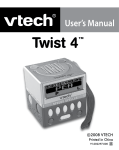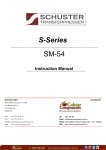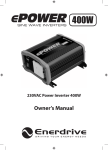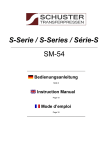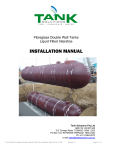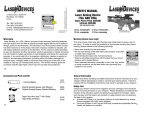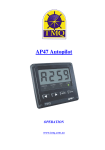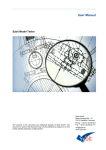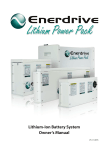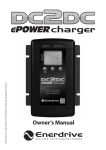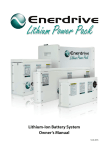Download User Manual
Transcript
MANUFACTURER: DISTRIBUTER: SCHUSTER Transferpressen GmbH Fritz-Reichle-Ring 20 78315 Radolfzell GERMANY FON: +49-7732-30279-10 FAX: +49-7732-30279-13 E-MAIL: [email protected] WEB: www.schuster-transferpressen.de Tel 1300 196 156 [email protected] Street 24/25 Ingleston Road, Tingalpa QLD. 4173 Australia Webwww.colourcomponents.com.au Tel 1300 196 156 www.colourcomponents.com.au T-Series ENGLISH __________________________________________________________________________ TP-54 Solo ________________________ TP-54 Twin Instruction Manual 1 Safety Advice ................................................................................................................................................................ 12 1.1 Manual Convention ............................................................................................................................................... 12 1.2 Important Security Advices................................................................................................................................... 12 1.3 Working with the Transfer Press........................................................................................................................... 12 2 Check Shipment............................................................................................................................................................. 13 3 Assembling and Bringing into Service .......................................................................................................................... 13 4 Settings .......................................................................................................................................................................... 13 4.1 Height Adjustment for the Work Plate.................................................................................................................. 13 4.2 Set Pressure ........................................................................................................................................................... 14 4.3 Time and Temperatur Controller........................................................................................................................... 14 4.3.1 Set Temperatur........................................................................................................................................... 14 4.3.2 Set Printing Time ....................................................................................................................................... 14 5 Printing Operation ......................................................................................................................................................... 15 6 Exchange Heat Element and Work Plate ....................................................................................................................... 15 6.1 Build in and Extend a Heat Element ..................................................................................................................... 15 6.2 Build in and Extend a Work Plate ......................................................................................................................... 15 7 Maintenance................................................................................................................................................................... 16 8 Problem Solving ............................................................................................................................................................ 16 9 Technical Specifications ................................................................................................................................................ 17 The SCHUSTER Transferpressen GmbH takes no responsibility for damages arising from misuse, reparations, and modifications which where carried out by third, not authorized parties, as well as for damages arising from non observance of the instruction manual. This handbook was constructed with great care, a liability for small negligent mistakes, for example printing error, however are excluded. The SCHUSTER Transferpressen GmbH takes no responsibility for damages or errors which arise from the use of accessory or spare parts which are not original pdeviceucts of SCHUSTER Transferpressen GmbH. Below SCHUSTER Transferpressen GmbH is identified as the manufacturer. Copyright © 2009 SCHUSTER Transferpressen GmbH. All rights reserved . - 10 - TP-54 Solo / TP-54 Twin ENGLISH Fig. 1: Front View TP-54 Solo Fig. 2: Back View TP-54 Solo with transport devices transport device control panel heat element work plate cramp single sliding table compressed air filter Fig. 3: Front View TP-54 Twin Fig. 4: Back View TP-54 Twin with transport devices transport devices control panel heat element work plates double sliding table clamp knob compressed air filter Fig. 5: Control panel time- & temperatur regulator manometer on-switch (one at each side) emergency stop pressure regulator main switch fuse holder 11 ENGLISH TP-54 Solo / TP-54 Twin 1 Safety Advice • Never try to maintenance the device on your own. Read through following advices before bringing the transfer press into operation. It is necessary to consider all warnings and advices indicated on the transfer press. • To ensure safe operations of the transfer press, the operator has to make sure that nonauthorized people neither work on the machine, nor set the machine into operation, or perform any other operations on the machine. • All operations on the transfer press can only be accomplished by specialised staff who gained an appropriate instruction or training. • General legal and other binding regulations for accident prevention and environmental protection are to be considered in addition to this instruction manual. 1.1 Manual Convention You can find this symbol in particular on important safety advices in this instruction manual, in which you will be advised about the right handling of the transfer press. The notes next to this symbol need special attention. If not considered, severe injuries may occur. It’s necessary to pay attention to security advices which are marked with this symbol. In case of non observance, burns of the user may occur. You also can find this symbol marked on some parts on the transfer press. 1.3 Working with the Transfer Press A symbol like this advices you, that through crushing, danger of injuries exists. You also can find this symbol marked on parts of the transfer press. • Look out not to touch the lower part of the heat element while the press is in operation, otherwise burns may occur. Please also note that there is still a danger to suffer burns even after turning off the transfer press for a longer time. • The case of the heat element will also be heating up; so be careful! 1.2 Important Security Advices This transfer press presents dangers if used inappropriately, or when used for a non intended use. For this reason, read carefully all of the following advices: • The transfer press may only be used for printings on pressure- and heat resistant materials. Every exceeding use is seen as non intended. If still used for non intended service, the manufacturer will not be liable for resulting damages. Unauthorized reconstructions and modifications are not permitted, because they will interfere with the security and the service of the machine. • Don’t insert any objects through the case notch. Also make sure that no fluid will reach the transfer press and the heat element. • The used mains voltage has to be the same as the stated mains voltage on the type plate of the transfer press. • During the operation of the press, and especially during the start; never put your hand between the work plate, the heat element, or the transfer press. Furthermore, make sure that no other person can reach the transfer press. • Please note following points to prevent damage on the machine and to achieve an optimal print result. Objects which (in a pressed condition) are not thicker than the recommended 5mm and do not cover the whole work plate; have to be placed into the center of the work plate. If it is not possible to centre the object, you have to cover the empty spaces with pads (of the same size). 2 Check Shipment • Watch out not to damage the power plug. TP-54 Solo with a single sliding table TP-54 Twin with a double sliding table • If you connect the transfer press over an extension cable, please make sure that the overall nominal current (of all connected equipment) does not exceed the allowed current load. Further make sure that the overall nominal current of all connected equipment does not exceed the allowed power supply of the connected electrical outlet. 1 x silicone foam pad 2 x silicone foam pads 1 x protective cover 2 x protective cover 1 x hexagon wrench button 1 x hexagon wrench button 1 x instruction manual 1 x instruction manual - 12 - TP-54 Solo / TP-54 Twin ENGLISH 3 Assembling and Bringing Into Service 1. Unpack the transfer press. 2. Bring the transfer press to it’s location of operation. Only use the assembled transport device to move the press. Make sure that no flammable or heat-sensitive materials or equipment are in immediate vicinity of the transfer press. 3. Remove the transport device. It is very important to keep them, because the transfer press can ONLY be moved through these transport devices. In particular; faults which will appear when trying to lift the transfer press up on other parts than the transfer devices, will be exempted from the warranty. It is especially unacceptable, to lift the transfer press at the sliding table or at the heat element. When you assemble the transport devices, make sure you plumb in the fixing screws tightly. 4. Remove the corrugated-head screws on the sliding table. Keep these as well for a further transport to secure the sliding table against slipping. corrugated-head screw on a double sliding table 5. Connect the power plug with an electrical outlet and connect the compressed air pipe to the compressed air filter (see page 11, Fig. 2 and 4). 6. Switch on the power switch to start the transfer press. 7. The transfer press will be ready for operations now. 4 Settings 4.1 Height Adjustment for the Work Plate 2 corrugated-head screw on a single sliding table 1 3 - 13 - 1. The first step will be to loosen the locking of the height adjustments. To do so, turn the clamp knob to the left. 2. Now turn the work plate in clockwise direction to lower it, or in anticlockwise direction to raise it. ENGLISH 3. TP-54 Solo / TP-54 Twin 4.3.1 Set Temperature When you reached your desired height, turn the clamp knob to the right to lock the height adjustment. The gap between the undersurface of the heat element and the upper surface of the article to be printed on, should be between 15 – 25 mm. Is the gap wider than 25 mm; the transfer press will automatically cancel the printing process for technical reasons, and the heat element will go back into its original position. 1. To set the temperature; push the button “temperature“once; the first cypher will start flashing. 2. Adjust the desired value with the „upwards“ button. 3. To change the value of the second cypher, push the button „to the right”; and the second cypher will start flashing. Use the same procedure to adjust the value. 4. To change the third cypher; use the same process like for the second cypher. 5. Push the button „temperature” to save the settings, as well as to leave the adjustment mode. 4.2 Set Pressure You can adjust the pressure with the pressure regulator; the manometer in the control panel serves as a control for your changes. The first step to change the pressure will be to pull out the pressure regulator (page 11, figure 5), then turn the pressure regulator to the right, to increase the pressure, to the left to reduce it. After you adjusted the desired pressure, push the pressure regulator back in to set the pressure. The light-emitting diode will flash “heating“, as long as the temperature set point is not reached yet. After heating up, the light-emitting diode will flash „O.K.“ after the transfer press reached the desired temperature. Usual values for sublimation prints: 3 – 5 bar. Recommended temperature value: 180 – 200 °C Maximum allowed pressure: 6 bar. 4.3.2 Set Printing Time 4.3 Time and Temperature Controller Two different printing times, t1 and t2, can be adjusted: t1 is the printing time over which you can determine the press duration of your object. With some objects it is necessary to pre-heat the object (without the art object). The time of the pre-heating can be adjusted with t2. 7 4 1 6 5 3 2 1. Push the button „time“, and hold it. In the display „time“ (lower display) “t1” (1. pressure time) and “t2” (2. pre-heating time) will flash for one second in turns. 2. To adjust the desired time value: Release the button „time“, when your desired time set point (t1. or t2.) is flashing in the display. Now only the first cypher should be flashing. Definition 3. Set the desired value with the button “upwards”. button „temperature“ button „time“ button „to the right“ button „upwards“ light-emitting diode „heating“ light-emitting diode „O.K.“ display „temperature“ display „time“ 4. To change the second and third cypher, push the button „to the right“. It will flash up. Set the value like you did with the first cypher. 8 Pos. 1. 2. 3. 4. 5. 6. 7. 8. If you push the button „time“; settings will be saved and you will leave the adjustment mode. Pre-heating time t2: Start your print operation and push the button “upwards”. After the expiration of t2, the control will automatically change back to t1. Acceptable values: 1. pressure time: 2. pre-heating time: Usual printing time: - 14 - 45 – 70 sec. 0-399 sec. 0-60 sec. TP-54 Solo / TP-54 Twin ENGLISH 2. 5 Printing Operation Now you have to loosen both retaining screws of the heat element with a 13-way spanner, and unscrew it for approximately 3-4 mm. After you adjusted your settings and the temperature is reached (the light-emitting diode “O.K.” will flash) – now you can begin with your printing operations. 1. If you have a TP-54 Solo; pull the sliding table out. 2. If you have a TP-54 Twin; pull the double sliding table to the left or right until it blocks. 3. Arrange the item and the corresponding artwork onto the work plate. Please note following points for an optimal print result and to prevent from damage: Objects which (in a pressed condition) are not thicker than 5mm and do not cover the whole work plate; have to be placed into the center of the work plate. If it is not possible to centre the object, you have to cover the empty spaces with pads (of the same size). Again, be aware of the damage which may occur from non-observance. 4. If you have a TP-54 Solo; push the sliding table back into the transfer press until it blocks. 5. If you have a TP-54 Twin; pull the double sliding table towards the opposite side until it blocks. 6. Confirm both starter buttons at the same time. 7. The heat element will lower and start the operation. After the printing time is over, the heat element will rise automatically and you will hear a beep. heat element plug holding screw 3. Lift up the heat element and pull it towards you. 4. To build in a heat element, do the same process in reversed order. 6.2 Build In and Extend a Work Plate 6 Exchange Heat Element and Work Plate 6.1 Build In and Extend a Heat Element Before you start to extend the heat element, assure yourself that the heat element has cooled down to room temperature. 1. At first remove the heat element plug. To do so; you first of all have to loosen the corrugatedhead screw of the heat element plug with a phillips screwdriver. Remove the heat element plug from the outlet. retaining screws Loosen both retaining screws on the underside of the work plate, then just pull the plate out towards you. - 15 - ENGLISH TP-54 Solo / TP-54 Twin 7 Maintenance collecting tray To ensure a permanent undisturbed operation of the pneumatic components, TP-54 Solo / TP-54 Twin includes a compressed air filter. This filter collects excessive water (which results from compressing air) into a collection container. Empty this collection tray as soon as a visible amount of water has formed. drain valve 1 To empty the collection container, the first step will be to remove the compressed air piping. Afterwards turn the drain valve (like demonstrated in the picture), and the water will run out. 2 To close the drain valve again, pull it down and simultaneously turn it (like in the image demonstrated direction). 8 Problem Solving Problem Transfer press does not work after pushing the start button After the printing process started, the heat element lowers but returns immediately into is original position. Work plate is twisting Reason Removal 1. Compressed air pipe is not connected. 2. Compressor is turned off 3. Pressure regulator is closed 4. Sliding table is not in end position 5. Start buttons didn’t get pushed at the same time 6. Pushed the emergency stop Work plate was set up to low/ the gap between heat element and work plate is too wide. Height is not adjusted insufficient locked in place. - 16 - or Connect the compressed air pipe with the compressed air filter (Ch. 3) Turn on the compressor Turn the pressure regulator to the left (Ch. 4.2) Push the sliding table until it blocks (Ch.5) Push the start buttons both at the same time (Ch. 5) Open the emergency stop Raise the work plate, clearance max. 25 mm (Ch. 4.1) Arrange the work plate and lock the right height adjustment through turning the clamp knob to the right - until the work plate is not twistable anymore. (Ch. 4.1) TP-54 Solo / TP-54 Twin ENGLISH 9 Technical Specifications External Dimensions L x W x H TP-54 Solo TP-54 Twin 920 x 478 x 528 mm 880 x 1150 x 528 mm Weight 80 kg Voltage 230 V Max. current consumption 9A Max. heating power 2000 W Temperature Up to 210°C 1. time domain: 0 - 399 sec. Time of pressure 2. time domain: 0 - 60 sec Max. pressure 6 bar Max. pressure at 6 bar 17 kN ≙ 1,7 t Max. surface pressure at 6 bar on a pressure surface of 40 x 50 cm 8,7 N/cm² Max. height of the article to be printed on ca. 50 mm 17









